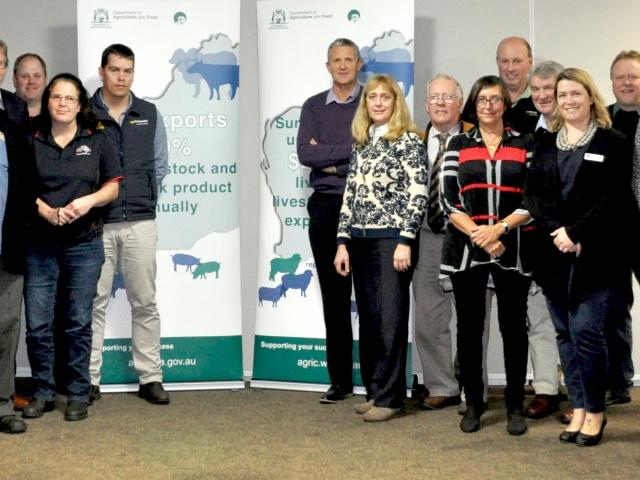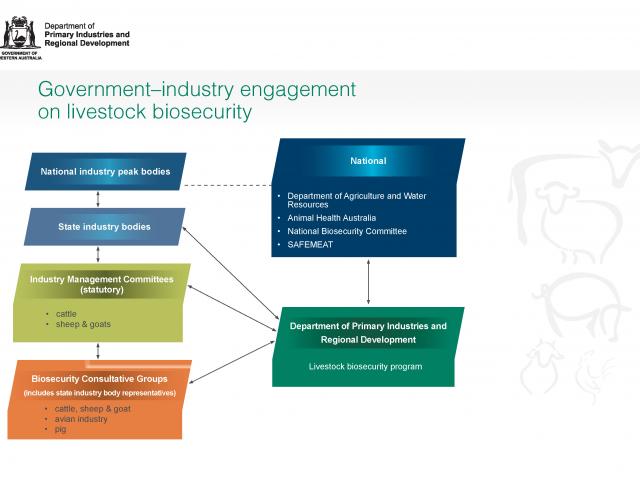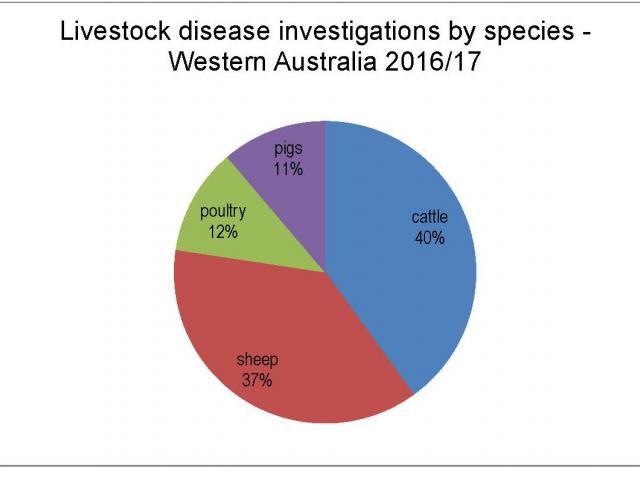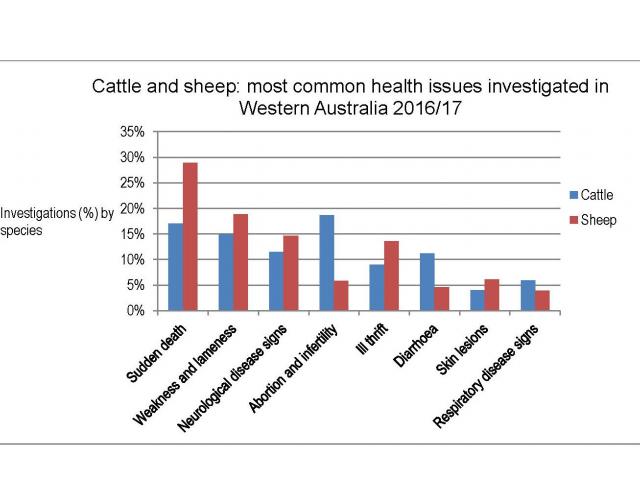New forum for sheep, goat and cattle biosecurity

The inaugural meeting of the Cattle, Sheep and Goat Biosecurity Consultative Group was held in Perth in June, bringing together representatives from the livestock industries, supply chain sector and government.
Established by the Department of Primary Industries and Regional Development, the newly formed group provides a forum to discuss current biosecurity issues relevant to Western Australia’s cattle, sheep and goat industries. Similar biosecurity groups already exist for the pig and poultry industries.
Department Livestock Biosecurity Director Peter Gray said the new group provides a platform for stakeholders to come together and ensure government and industry are partnering to protect and manage the health and biosecurity status of WA’s livestock and livestock product.
“The turnout from industry was really pleasing; we had broad representation from our state and sector producer groups, livestock agents, processors and government partners,” he said.
“The inaugural meeting covered topical issues including an explanation of the Johne’s Beef Assurance Score (J-BAS) and the development of on-farm biosecurity plans for producers seeking to maintain a J-BAS 6, 7 or 8.
“The national changes to the management of Johne’s disease in cattle was of particular interest and this meeting provided an opportunity to clarify how the tools developed by Animal Health Australia on behalf of Cattle Council of Australia can be used to manage the risk of Johne’s disease in cattle for individual farm businesses,” Dr Gray said.
Renata Paliskis, Deputy Chair of the Cattle Industry Funding Scheme Management Committee, and Guy Bowen, a member of the Sheep and Goat Industry Funding Scheme Management Committee, outlined funding priorities for the next financial year. These priorities include surveillance to support the regulatory program to maintain WA’s negligible prevalence of Johne’s disease in cattle and further support to the virulent footrot control program in sheep.
Department Animal Health Surveillance Manager Marion Seymour gave an overview of current surveillance activities, including upcoming engagement with industry on the development of a WA surveillance plan.
Department Research Officer Marc Poole highlighted the importance of early detection for exotic disease with a case study on the market access implications of the recent tomato potato psyllid incursion into WA.
1000+ reasons for WA’s high animal health status
In 2016/17, Western Australian producers again provided evidence of the state’s excellent livestock health status with more than 1000 calls to a vet to investigate and submit laboratory samples when animals showed signs of illness.
Animal Health Surveillance Manager Marion Seymour said that WA producers and vets were the frontline of the state’s animal health surveillance team.
“When a producer calls their vet when animals show signs of disease, the results from the testing are used to support Australia’s proof of freedom from serious diseases that could affect human health, livestock production or trade.
“The producer also benefits directly from a diagnosis of the cause of disease, which allows them to adjust their management so that they can prevent the disease in future.
“Last financial year, the Department’s veterinary pathologists carried out more than a 1000 investigations into animal health, with more than 900 of these on the main commercial livestock species – cattle, sheep, pigs and poultry,” Dr Seymour said.
Livestock disease investigations by species – Western Australia 2016/17
“Importantly, not only did producers contact a vet on a range of livestock species for investigation, but the investigations also occurred across Western Australia, demonstrating that our surveillance systems are widespread across livestock production areas and that we are likely to recognise any serious diseases that may occur at an early stage.
“But we can’t afford to be complacent. As WA exports about 80% of our livestock and livestock products every year, valued at about $2b annually, it is vital that everyone who works with livestock, including producers, vets, stock agents, transporters and processors, reports sick livestock signs to their private vet, a Department vet or the Emergency Animal Disease hotline on 1800 675 888,” Dr Seymour said.
Most common health issues
Dr Seymour said sudden death, weakness and lameness, neurological disease signs and abortion and infertility topped the list of the most common health issues investigated.
“It is vital to investigate disease signs like these because while they are most likely due to an endemic disease or management issue, there is a chance that they could be an exotic disease.
“The signs of some reportable and exotic diseases can look similar to common diseases. For example, sudden death could be due to anthrax, while lameness occurs in foot-and-mouth disease and mad cow disease would present with neurological signs.
“In 2016/17, more than 400 of the sheep and cattle cases submitted for laboratory investigation were also tested for reportable and exotic diseases, providing evidence to our domestic and international markets that we were free of these exotic diseases.
“Sheep and cattle owners also received a diagnosis, which helped them to improve productivity and profitability.
“For cattle, the top three most common diagnoses were pneumonia caused by bacteria such as Pasteurella, rotavirus diarrhoea and selenium deficiency, while for sheep, worms (scour or Barber’s pole) were the main issue, followed by ovine Johne’s disease and pneumonia caused by bacteria such as Pasteurella.
“The Department of Primary Industries and Regional Development continues to subsidise these disease investigations to support WA producers’ ongoing access to premium markets for livestock,” Dr Seymour said.
New representative for WA’s Livestock Biosecurity Network
The importance of farm biosecurity plans was a key topic discussed at a recent meeting of Department of Primary Industries and Regional Development staff and Livestock Biosecurity Network’s recently appointed Manager, WA Biosecurity and Extension, Frances Gartrell.
Livestock Biosecurity Network (LBN) is an independent national industry initiative, supported by Animal Health Australia and Cattle Council of Australia. It works in collaboration with industry and state and federal agencies to address industry concerns about responses to existing or emerging biosecurity threats to livestock production in all jurisdictions.
Ms Gartrell joined LBN in April and is currently focusing on biosecurity issues affecting the cattle sector, in particular assisting WA cattle producers to prepare biosecurity plans to maintain their Johne’s Beef Assurance Score (J-BAS).
Department of Primary Industries and Regional Development Animal Disease Control manager Bruce Twentyman said implementing sound on-farm biosecurity practices is one of the best defences against pests and diseases.
“A farm biosecurity plan guides farmers toward simple everyday practices that can help protect farm properties from biosecurity risks,” Dr Twentyman said.
“Having a current farm biosecurity plan in place is an excellent tool for detecting and managing livestock disease risks.
“For example, a good plan can help with early detection of exotic diseases such as foot-and-mouth disease and swine fever, diseases that, if they came into Australia, could have crippling effects on individual producers and the broader livestock sector.
“A biosecurity plan can also help farmers manage risks to their business and reduce the economic impacts associated with other livestock diseases such as Johne’s disease, footrot and lice.”
Dr Twentyman said Livestock Production Assurance (LPA) will also require an on-farm biosecurity plan as part of its membership from 1 October 2017.
“Developing a biosecurity plan for your farm needn’t be complicated. There are a number of templates available from websites including Animal Health Australia and Livestock Biosecurity Network,” he said.
Frances Gartrell has a background in communications and workplace training, and has previously worked in the livestock and tertiary education sectors, most recently at the University of Western Australia. For more information about on-farm biosecurity plans, Ms Gartrell can be contacted at: fgartrell@lbn.org.au.
Benefits of livestock health monitoring under the spotlight
Western Australia’s livestock sector is set to benefit from a stronger livestock health monitoring capacity, following attendance by the Department of Primary Industries and Regional Development at a recent international conference.
The International Conference on Animal Health Surveillance was hosted by the New Zealand Veterinary Association in Rotorua in May. Attendees explored how livestock industry participants can work together to achieve more effective and efficient livestock health monitoring.
Department Acting Chief Veterinary Officer Jamie Finkelstein said the conference highlighted the importance of livestock health surveillance and partnerships.
“When it comes to market access, it’s absolutely crucial that buyers have confidence in our product,” he said.
“A major part of that confidence comes from our ability to detect changes in livestock health early.
“Increased focus on livestock health monitoring, together with greater collaboration among those in the livestock sector, can enhance livestock production, support early disease detection and assist our ability to demonstrate freedom from trade-relevant diseases.
“The conference was an excellent opportunity to keep up to date with the latest information on livestock health monitoring practices, helping to strengthen our capacity to maintain WA’s favourable livestock health status.
“One of the topics explored at the conference was the trend toward collating livestock health monitoring data from a range of sources including government agencies, industry and commercial organisations.
“The aim is to create an integrated system that provides timely livestock health data for those in the livestock sector,” Dr Finkelstein said.
“Being able to access more information can increase awareness of livestock health matters and help producers recognise a change in livestock health sooner rather than later.
“As well as minimising the impact of livestock ill-health on individual producers, livestock health surveillance supports WA’s market access for livestock and livestock products by demonstrating that we’re looking for and that we are free from trade-relevant diseases.”
To find out more about how livestock health data supports WA’s ability to trade livestock, see the Department’s animal health surveillance webpage.
National committee meeting in Perth sets animal health policy
Animal health experts from across Australia met in Perth in April to discuss policy, research and achievements in the animal health sector.
The Animal Health Committee meets in person twice a year, bringing together Australian and jurisdictional chief veterinary officers, the Australian Animal Health Laboratory manager, and senior policy officials from government and other organisations. The committee also meets with national and local industry representatives.
The three-day meeting in Perth was hosted by the Department of Agriculture and Food, Western Australia (now the Department of Primary Industries and Regional Development).
Department Acting Executive Director Mia Carbon said the meeting built capacity in the sector.
“The meeting was an excellent opportunity to share knowledge and explore issues affecting animal health, particularly around surveillance for livestock diseases, traceability, and preparedness to respond to an emergency animal disease in Australia,” she said.
“It also allowed committee members to meet with local industry representatives.
“With around 80 per cent of WA livestock and livestock product exported overseas each year, it’s critical that animal health surveillance data is available to uphold Western Australia’s reputation as a provider of high quality, safe product. This relies on our national animal health system, in which producers, industries and private veterinarians play a key role.”
Meeting attendees progressed a range of topics including horizon scanning and foresighting tools for animal health, delivery of the National Animal Health Surveillance and Diagnostic business plan, cost-sharing a national livestock standstill, and the new national approach to Johne’s disease in cattle.
Attendees also joined a field trip highlighting WA’s animal export industry.
For more information about the Animal Health Committee, including its latest communique, visit the Federal Department of Agriculture and Water Resources website.
Prosecution highlights importance of livestock traceability
A prosecution earlier this year highlights the critical role livestock identification and movement regulations have in managing disease outbreaks and maintaining market access.
In February, the Department of Agriculture and Food, Western Australia (now the Department of Primary Industries and Regional Development) successfully prosecuted a Denmark producer for repeatedly failing to comply with livestock identification and movement regulations.
Department Animal Integrity Systems manager Bob Vassallo said the case emphasised how non-compliance can have a detrimental effect on the broader livestock sector.
“The vast majority of producers do the right thing, however, prosecutions are a last resort when other avenues have failed,” he said.
“Non-compliance with regulations severely compromises the ability to trace livestock in the event of a disease outbreak or chemical residue incident.
“Western Australia has a well-earned reputation as a producer of disease-free and residue-free livestock. That enviable status underpins our access to international markets.”
“This reputation relies on WA producers, the Department, and the Commonwealth being able to provide trading partners with high levels of assurance about our ability to trace livestock for disease or residue issues. This can only happen if all sectors of the livestock industries are compliant with the regulations that underpin traceability.
“In the event of a significant animal disease outbreak such as foot-and-mouth disease, the sooner all livestock can be traced, the sooner the outbreak can be controlled. A swifter response will also soften the financial burden," Dr Vassallo said.
Producers are encouraged to visit the Department’s website or contact to contact Beth Green on 9753 0302 or Jack Nixon on 9780 6222 if they have questions about stock identification or movement.



